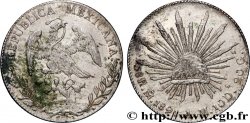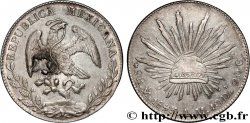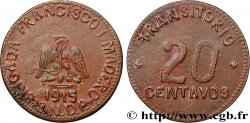- Accueil
- > Archiv
- > Weltmünzen
fwo_550137 - MEXIKO 20 Pesos “Pierre du Soleil” (calendrier aztèque) 1921 Mexico
Nicht verfügbar.
Artikel auf unserem Online-Shop verkauft (2019)
Preis : 800.00 €
Artikel auf unserem Online-Shop verkauft (2019)
Preis : 800.00 €
Type : 20 Pesos “Pierre du Soleil” (calendrier aztèque)
Datum: 1921
Name der Münzstätte / Stadt : Mexico
Prägemenge : 922000
Metall : Gold
Der Feingehalt beträgt : 900 ‰
Durchmesser : 27,2 mm
Stempelstellung : 6 h.
Gewicht : 16,68 g.
Rand inscrite en creux
Seltenheitsgrad : R1
N° im Nachschlagewerk :
Vorderseite
Titulatur der Vorderseite ESTADOS UNIDOS MEXICANOS / 1921.
Beschreibung Vorderseite Aigle debout à gauche sur un cactus, lui-même poussant sur une pierre, et terrassant un serpent au-dessus d’un lac bordé par deux branches composites ; dans le champ le millésime.
Übersetzung der Vorderseite (États-Unis du Mexique).
Rückseite
Titulatur der Rückseite VEINTE PESOS/ *15 GR. ORO PURO*.
Beschreibung Rückseite Pierre du soleil ou “Calendrier aztèque”.
Übersetzung der Rückseite (Vingt pesos/ 15 grammes d'or pur).
Kommentare
Cet exemplaire est la frappe d’origine et est difficile à trouver. La “Pierre du Soleil” est un disque monolithique de 3,60 m de diamètre et 1,22 m d’épaisseur et pesant 24 tonnes. Découverte par hasard en 1790 à Mexico lors du pavage d’une place, cette pierre serait un autel sacrificiel sculpté sous le règne de l’empereur aztèque Axayácatl. Elle est conservée au Musée National d’anthropologie de Mexico.
This example is the original strike and is difficult to find. The “Sun Stone” is a monolithic disc 3.60 m in diameter and 1.22 m thick, weighing 24 tons. Discovered by chance in 1790 in Mexico City while paving a square, this stone is believed to have been a sacrificial altar carved during the reign of the Aztec emperor Axayácatl. It is housed in the National Museum of Anthropology in Mexico City.
This example is the original strike and is difficult to find. The “Sun Stone” is a monolithic disc 3.60 m in diameter and 1.22 m thick, weighing 24 tons. Discovered by chance in 1790 in Mexico City while paving a square, this stone is believed to have been a sacrificial altar carved during the reign of the Aztec emperor Axayácatl. It is housed in the National Museum of Anthropology in Mexico City.








 Berichten über einen Fehler
Berichten über einen Fehler Die Seite drucken
Die Seite drucken Teilen meiner Auswahl
Teilen meiner Auswahl Stellen Sie eine Frage
Stellen Sie eine Frage Einlieferung/Verkauf
Einlieferung/Verkauf
 Details
Details









